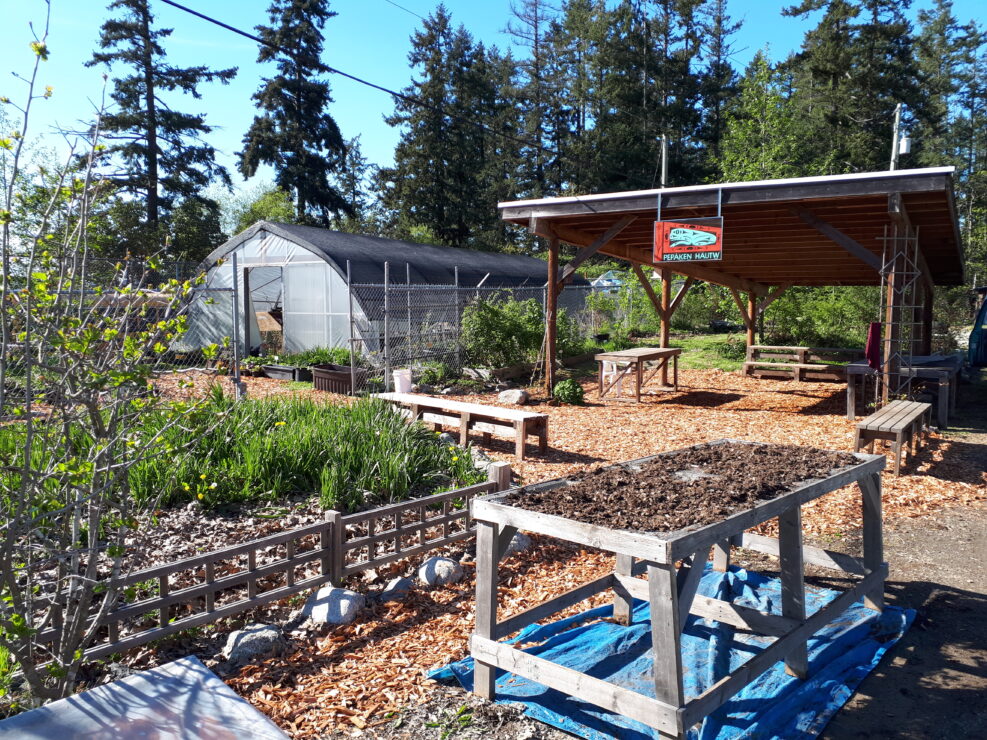
Education initiatives support cultural revitalization through restoration work
What began as a native plant nursery has blossomed into a local non-profit organization that aims to revitalize native ecosystems in W̱SÁNEĆ homelands. Through ecological restoration and participatory education programs with the ȽÁU,WELṈEW̱ Tribal School, PEPÁḴEṈ HÁUTW̱, which means “Blossoming Place” in SENĆOŦEN, supports Indigenous cultural resurgence and educates about food sovereignty.
“Often I say that what we do is ecosystem restoration,” said Judith Lyn Arney, the ecosystems director and one of the founders of PEPÁḴEṈ HÁUTW̱, in an interview with the Martlet. “Because … it encompasses everything. It encompasses political systems, it encompasses social systems, it encompasses relationships between plants and animals and humans.”
PEPÁḴEṈ HÁUTW̱ is on the grounds of the ȽÁU,WELṈEW̱ Tribal School, at the base of ȽÁU,WELṈEW̱ (Mount Newton) in Brentwood Bay. The organization runs weekly programs to teach kids from the school about traditional and healthy food systems, as well as broader topics such as food security and ecosystem stewardship.
The organization is involved in ecological restoration initiatives around W̱SÁNEĆ territory. Their main project is the SṈIDȻEȽ (Tod Inlet) Resiliency Project, which focuses on restoration work in and around the site of the first W̱SÁNEĆ village.
Arney told the Martlet that PEPÁḴEṈ HÁUTW̱ grew out of her master’s work with York University in 2011. An ethnoecologist of British ancestry, Arney grew up on W̱SÁNEĆ homelands and focused on service learning during her education. In service learning, the goal is to achieve real objectives in the community by combining education with community service. Arney says that it was important to her that her graduate work would have a positive impact in the real world, not just be put on a shelf.
PEPÁḴEṈ HÁUTW̱ grew organically into a collaborative education project for kids at the Tribal School and officially became incorporated as a non-profit in 2016. It is now headed by PEPAḴIYE Ashley Cooper, a local from W̱JOȽEȽP in W̱SÁNEĆ territory, whose focus is on SENĆOŦEN language revitalization.
PEPÁḴEṈ HÁUTW̱ works collaboratively with a diverse team of staff. XEṮXÁṮEN Earl Claxton Jr. is a SȾÁUTW̱ Elder who joined the program in its early days after recovering from brain surgery. In an email to the Martlet, Claxton says he became interested in the program out of a desire to learn skills that would be useful to his community, like growing vegetables. Claxton now works at PEPÁḴEṈ HÁUTW̱ with a focus on reintroducing camus bulbs back into diets, as well as reinstating traditional cooking methods like fish-on-a-stick and pit cooking.
According to Arney, “The seed of it was my graduate work, but certainly, it’s the result of a lot of co-creation with community members and people like PEPAḴIYE Cooper coming in.”
PEPÁḴEṈ HÁUTW̱ has grown from its beginnings as a native plant nursery into a collaborative community organization. It is partnered with the Living Lab Project at the University of Victoria on the ȾIKEL (Maber Flats) Restoration Project, using land-based learning to educate kids at the Tribal School about native ecology and the uses of plant material in wetland areas.
PEPÁḴEṈ HÁUTW̱ has also partnered with the Tsawout First Nation on S,DÁYES (Pender Island) on a restoration project and with the Horticulture Centre of the Pacific to create a self-guided “Ethnobotany Trail” for visitors to learn about native plant species.
While Arney is proud of what PEPÁḴEṈ HÁUTW̱ has grown into, she says that they have lofty visions for the future of restoration work.
“We want to see restoration teams all around the region and beyond, funded without having to chase grants all the time,” said Arney. “It is technically the UN ‘Decade of Ecosystem Restoration,’ so we want institutions to put their money where their mouth is and really do something substantial and structural to make real change in the world.”
In terms of the bigger picture, Arney says PEPÁḴEṈ HÁUTW̱ is an example of what can happen when people are dedicated to service learning. Arney emphasizes that students need to really think about what they want their work to do for the community.
“We’ve got a new future ahead of us that none of us have ever seen before and we don’t have precedent for it,” said Arney. “So, it’s up to us to create it. And I hope that we can all participate in a culture that’s based on healing and doing that good work together.”








